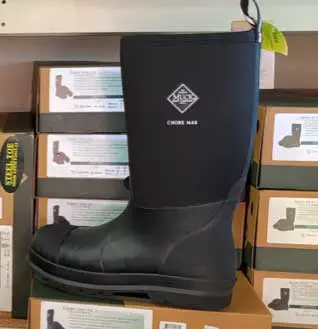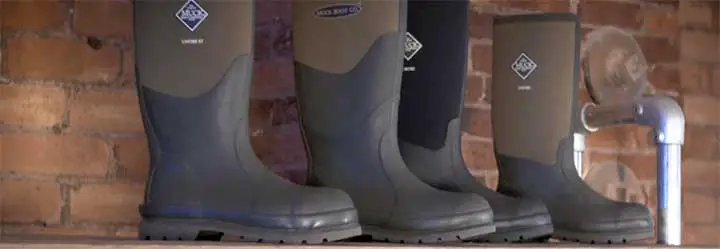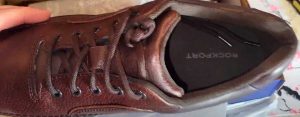When shopping for waterproof boots to keep your feet warm and dry during cold, wet weather, two brands you’re likely to encounter are Bogs Footwear and The Original Muck Boot Company (known simply as “Muck Boots”).
Both Bogs and Muck offer popular boot options, but with so many styles and designs to choose from, it can get confusing trying to decide which brand might better suit your needs.
A Brief Comparison Table
To help compare the differences between Bogs and Muck boots, here’s an overview of key factors that set them apart:
| Category | Bogs | Muck Boots |
| Known for | Max-Wick moisture-wicking insoles | Fit2U sizing for wider feet |
| Proprietary Neo-Tech insulation | Lightweight Flex-Foam construction | |
| Most popular styles | Bogs Classic Mid, Bogs Amanda Plush, Bogs Sauvie Slip-On | Muck Arctic, Muck Wetland, Muck Woody Max |
| Ideal uses | Gardening, walking, outdoor recreation | Farming, construction, hunting |
| Waterproof rating | 100% waterproof construction | 100% waterproof full rubber shell |
| Insulation type | Max-Wick + Neo-Tech insulation | Fleece lining + optional Muck Warm layer |
| Outsole design | Rebound self-cleaning lugs | Rugged triangular or hexagonal lugs |
| Sizing | Runs at least 1⁄2 size too large | Size up for wide widths |
Both Bogs and Muck utilize waterproof rubber and insulted lining to keep feet warm and dry. But they differ in traction, insulation levels, fit/sizing, and optimal uses.
When choosing between the two brands, consider:
Bogs Strengths

- Unrivaled cold weather insulation down to -40°F / -40°C
- Shock absorbing Rebound cushioned heels and forefoot
- Odor fighting antimicrobial protection
- Self-cleaning soles great for mucky terrain
Bogs Weaknesses
- Loose, roomy fit runs quite large
- Heavy for all-day wear without breaks
- Expensive for casual intermittent use
Muck Strengths
- Fit2U sizing great for wide widths
- Flexible lightweight construction
- Rugged lugged outsoles provide grip
- Breathable fleece lining
Muck Weaknesses
- Thinner fleece lacks extreme cold insulation
- Dark colors fade over time
- Runs short, sizes large
Also Read: Differences Between Dryshod And Muck Boots.
Evaluating Key Differences Between Bogs and Muck
From construction to sizing and ideal scenarios, several major differences emerge when comparing Bogs vs. Muck boots. Keep these key factors in mind when deciding which footwear brand better matches your needs:
Traction and Sole Design

- Bogs uses a proprietary Rebound sole focused on bounce-back cushioning to reduce foot fatigue. Round self-cleaning lugs shed mud and debris as you walk so built-up muck doesn’t compromise traction.
- Muck employs rugged triangular, rectangular and hexagonal lugs for superior grip across slippery, uneven terrain. Lugs vary by style from aggressive deep treads to multi-directional shallow lugs delivering flexibility and reinforcement simultaneously.
Insulation and Lining
- Bogs leverages Max-Wick moisture-wicking insoles to actively pull sweat away from feet. Its Neo-Tech fabric insulation retains heat in frigid conditions down to -40° F / -40° C.
- Muck relies on soft fleece lining for lightweight, breathable warmth across most boots. But Muck Arctic styles upgrade to extreme cold weather insulation comparable to Bogs Neo-Tech.
Waterproofing Rating
- Both Muck and Bogs rate 100% waterproof, making feet impervious to external moisture. Each utilizes waterproof bootie construction sealed snugly by the exterior rubber shell.
- During heavy rainfall or snowmelt, both brands ensure water beads atop the exterior rather than compromising the inner chambers. Vent holes allow airflow and ventilation to prevent interior condensation.
Sizing and Fit
- Bogs runs quite large with most users sizing down for the best snug fit. Expect to buy anywhere from 1⁄2 to a full size below your regular shoe size.
- Muck leans narrow but offers Fit2U multi-width options suiting wider feet. Size up or select wide widths to prevent squeezed toes or lost circulation.
Also Read: Comparison of Lucchese And Rios of Mercedes Boots.
When To Choose Bogs Or Muck Boots?
With those key performance differences clarified, Bogs and Muck fill particular niche uses:
Pick Bogs For:
- Gardening in cold climates
- Winter dog walking
- Clearing snow
- Ice fishing
- Farming chores below freezing
- Moderate winter hiking
Bogs insulated boots equipped with Neo-Tech excel when you’re sedentary or moderately active in frigid temperatures. The combination of sweat-wicking lining and heat-trapping exterior protects against frozen ground and icy conditions.
Cushioning Rebound soles also provide shock absorption for lengthy hours on your feet, reducing lower body fatigue.
Styles to Consider:
- Bogs Classic Mid Winter Snow Boot
- Bogs Amanda Waterproof Insulated Boot
- Bogs Sauvie Waterproof Insulated Shoe
Pick Muck For:
- Hunting long hours sitting still
- Working outdoors walking over mixed terrain
- Landscaping across slippery slopes
- Farming chores crossing muddy pastures
- Light hiking with frequent elevation changes
Muck’s deep lugged outsoles, molded Fit2U shape, and lightweight Flex-Foam construction flex naturally with varied footing across rugged topography. The breathable boot shaft releases excess interior moisture from active wear better suiting temperate weather, with fleece lining retaining warmth down to near-freezing temperatures.
Styles to Consider:
- Muck Arctic Pro Hunting Boot
- Muck Wetland Rubber Work Boot
- Muck Woody Max Mid Height Boot
Usage Scenarios and Reviews: How Real Customers Rate Each Brand

To gather insight from actual boot wearers, here are excerpts of Bogs and Muck owners describe their experience with each brand and how the boots held up during real-world use:
“Living in Vermont, I need a warm winter boot to clear snow from my long driveway after storms. My Bogs Classic Mid boots keep my feet toasty down to -20°F before I even feel a chill. And the deep grippy tread never slips across compact snow and ice.” – Brian S.
“I bought Muck Arctic Pro boots for late season hunting when icy mornings dip down into the teens. Even sitting still for a few hours, my feet stayed warm in fleece lining. But the real magic lies in the Quad Comfort fit adjustability securing snug around my calves over long johns.” – Wyatt K.
“Working on my farm every day tending livestock and fixing fences, Muck Wetland boots stand up to heavy use crossing muddy terrain and messy stalls. The high-traction grippy soles maintain steady footing across uneven slippery ground, reinforced in high wear areas” – Hannah R.
“Living in the Pacific Northwest, we get a ton of rain. When walking my dogs on local trails, I want waterproof boots with flexibility and support. My Woody Max Mucks keep my feet bone dry through puddles while the breathable lining prevents sweating. They feel sturdy yet light even after miles of uneven ground.” – Alex T.
These real customer experiences reinforce how Bogs perform protecting against frigid winter temps while Muck Boots equip wearers for varied terrain found working, hiking and hunting in wet moderate climates.
Also Read: Comparison of Blundstone And Duckfeet Boots.
Frequently Asked Questions (FAQ)
Common questions that arise when shoppers evaluate Bogs and Muck boots:
Bogs insulate better in freezing weather under 20°F. But Muck Boots accommodate wider feet more comfortably while providing better traction across uneven terrain when worn for lengthy hours.
So Bogs excels for casual cold weather use like winter dog walking or gardening. But Muck makes a better pick for occupations like farming, construction and hunting that require all-day reinforced footing in temperate climates.
Both boot brands effectively seal moisture when traversing rain and snow.
1. Bogs runs quite large, usually requiring you to size down anywhere from 1⁄2 to a full size.
2. Muck Boots generally runs short and narrow until you reach wide widths or certain hunting/fishing styles equipped with Fit2U adjustable calf circumference.
When trying on Bogs and Muck models, use your larger foot’s measurements matching the mondo sizing rather than relying on your typical shoe size.
For Bogs, size down at least a half or full size, trying both if between sizes to ensure your heel and toes don’t swim loose or bump the edges.
For Muck Boots, consider sizing up a half size if your feet spill over the contour of the insole or feel squeezed width-wise to allow a comfortable custom mold fit instep.
1. Sperry Avenue Duck Boot: Also rated for temperatures as low as -20°F with a more streetwear look.
2. Kamik Canuck Cold Weather Boot: 600g insulation protects against freezing rain and snow.
3. XTRATUF Legacy Series: Commercial fishing/boating work boot with Chevron outsole.
4. Muck Arctic Weekend: Direct Muck comparison with -40° rated insulation.
5. Servus Comfort Boot: 15” PVC boot with steel toe protection.
Each challenger matches Bogs Boots for cold weather insulation and waterproofing. But none replicates Bog’s proprietary Rebound cushioning and Max-Wick moisture-wicking insoles.
Generally, no – Muck boots fit more true-to-size in most models unlike Bogs’ notoriously loose fit. But for wide widths, hunters and fishers should size up in Mucks to allow feet to fully settle within the molded shape.
Arctic-style Mucks with insulation also suggest ordering a half-size up to accommodate layering thick socks underneath. Otherwise, standard Muck sizing only runs large in terms of narrowed toe boxes requiring break-in stretching.
Neither boot brand puts a strong focus on built-in arch support. Both Bogs and Muck offer ordinary contouring and stability akin to standard boots.
For those needing extra arch reinforcement for foot pain conditions, consider adding your own orthotic insoles with custom medial arch and metatarsal padding shaped to your feet.
The Bottom Line: Key Considerations Choosing Between Bogs and Muck
At the end of the day, comparing Bogs and Muck Boots comes down to these purchase considerations before clicking buy:
- Evaluate the winter temps and conditions you expect to encounter. Prioritize rated insulation and lining accordingly.
- Dial-in the right size accounting for large Bogs fits and narrow Muck sizing. Focus on your larger foot’s measurements.
- Determine priority features – sweat-wicking insoles, self-cleaning soles, odor control or storage options.
- Match sole grip and stability demands to your expected terrain and activity.
- Weigh cost per wear over expected lifespan for durability.
Once your criteria and non-negotiables firm up, choosing the right boot brand and style for your lifestyle and environmental exposure becomes straightforward. Confidently stride through rain, ice, snow and mud puddles all season long in Bogs or Mucks boots knowing your feet stay cozy warm and bone dry for miles.




I have never tried the BOGS brand. I live and hunt in south Arkansas temperature range 90 to 0 degrees. I have used the Muck Edgewater around my property and during hunting Season. Both for a lot of walking and sitting for close to 30 years. My first pair was bought by accident on a closeout at a sporting goods store. Since then I have bought a total of 6 pair for myself and two pair for my wife. I like the roll down top feature of these boots I wear a size 8 shoe and have always bought and worn these boots in a size 9. plenty of room, very comfortable foot bed and very light weight feel similar to wearing tennis shoes. A person should be sure to wear pants on the outside of the boot while traveling through brush and briars.